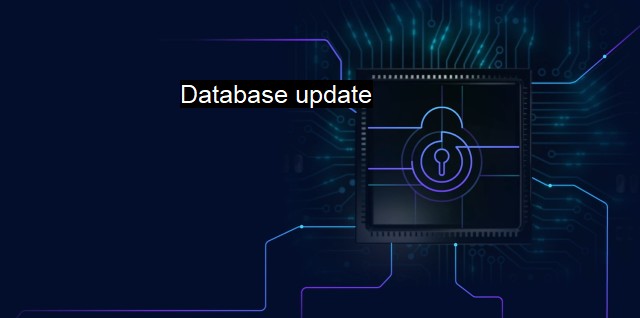What is Database update?
Why Database Updates Are Vital for Cybersecurity: Understanding Their Significance in Antivirus and Threat Prevention
A database update in a cybersecurity context often refers to the process of ensuring the protection measures, such as antivirus programs, have the latest information necessary to protect against threats. This data helps in identifying and eradicating any harmful aspects affecting a system, including but not limited to, malicious software (malware), privacy leaks, ransomware, adware, phishing, and other forms of cyber threats.When discussing cybersecurity, it's crucial to understand that the cyber domain is a dynamic and unstable field with a continuously changing risk landscape. Cyber miscreants consistently create new ways to initiate attacks, which make it significantly difficult for antivirus and cybersecurity applications to maintain their efficacy. That's where database updates come into play. They encompass the latest information about current threats and malware, filling the gaps in the security system and ensuring entities can defend against new evolutionary cyber threats.
In anti-virus programs, these database updates are often known as virus definition or signature updates. A signature is a unique set of characteristics of a specific virus, malware, or a cyber-attack network. It helps the antivirus program for its detection, identification, and removal from an infected system. Without regular and cutting-edge updates to its signature database, an antivirus program wouldn't sufficiently protect a system or network from the newer types of viruses and malicious software threats.
Signature updates aren't just for detecting threats; they also enhance the heuristics of the antivirus or security program. Heuristics are the investigative techniques that these programs use when they are unsure if a file or process is harmful or benign. Signature updates often come combined with updated, advanced heuristics that enable a cybersecurity system to evaluate unidentified or ambiguous software better and discern if they constitute threats.
On a broader scope, database updates are also integral parts of more advanced Cyber Security tools and services such as Intrusion Detection/Prevention Systems (IDS/IPS), Security Information and Event Management (SIEM) systems, and newer Endpoint Detection and Response (EDR) solutions. They not only rely on updated virus signatures but also updated behavioral patterns, anomalies, or Indicators of Compromise (IoCs).
In a world where new cyber threats emerge every day, database updates are a proactive measure to ensure maintained and enhanced protection. Delaying or not implementing these updates can provide hackers an opportunity to reach confidential data or worse, damage an organization's databases, networks, or endpoints.
Database updates might also include software and patches for any found security vulnerabilities or bugs. They are an integral part of what is known as security hardening, which is the process of fortifying systems and reducing the surface of vulnerability.
The role of database updates in cybersecurity is unignorable. Regular updates provide the aid required to keep cybersecurity software on par with the ever-evolving tactics of cybercriminals. They aren't just about maintaining a static level of protection or catching up with new threats; they are key to ensuring the growth, adaptability, and overall effectiveness of a cybersecurity system. Therefore, database updates are indispensable for cybersecurity and antivirus effectiveness in an eco-system subjected to constant shifts and changes in the landscape of digital threats.
Thus, any mistake in keeping databases updated can potentially pose a disastrous cyber threat to an organization, which might harm its digital infrastructure, network, data, reputation, and trustworthiness. Hence, assuring database updates regularly and promptly in an automated manner using trustworthy channels is a powerful move in the world of cybersecurity management.

Database update FAQs
Why is it important to regularly update your antivirus database?
Regularly updating your antivirus database ensures that your antivirus software has the latest information about known viruses and malware. This means it can detect and prevent the latest threats from infecting your system, keeping your data and network secure.How often should I update my database for optimal cybersecurity?
It is recommended to update your antivirus database at least once a day to ensure you have the latest protection available against new and emerging threats. However, some antivirus software may update more frequently or less frequently depending on the settings and preferences you choose.What should I do if my antivirus database update fails?
If your antivirus database update fails, check your internet connection to make sure it is stable and strong. If your connection is fine, try restarting your computer and attempting the update again. If the update continues to fail, contact your antivirus software provider for assistance.Can I set my database updates to occur automatically?
Yes, most antivirus software provides an option for automatic database updates. This ensures that your software is always up-to-date with the latest protection without requiring manual updates from you. Check your software settings to make sure automatic updates are enabled.| | A | | | B | | | C | | | D | | | E | | | F | | | G | | | H | | | I | | | J | | | K | | | L | | | M | |
| | N | | | O | | | P | | | Q | | | R | | | S | | | T | | | U | | | V | | | W | | | X | | | Y | | | Z | |
| | 1 | | | 2 | | | 3 | | | 4 | | | 7 | | | 8 | | |||||||